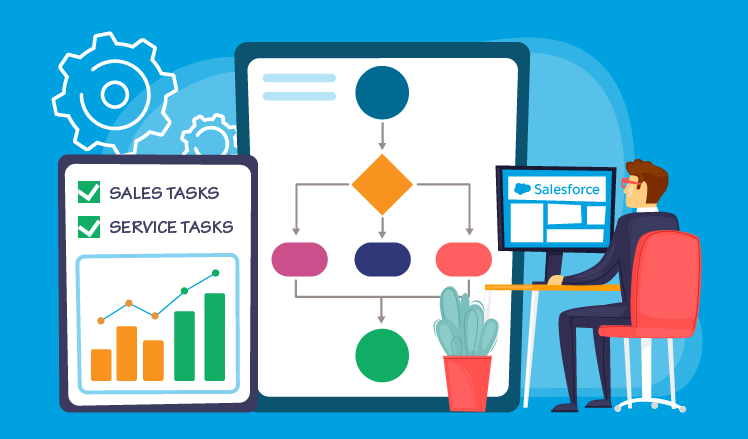How Salesforce Workflow Automation May Save 1 Hour a Day
Editor's note: A CRM consulting company in the filed since 2008, ScienceSoft knows a lot about time-saving automation enabled by a properly designed CRM system. We are happy to share the knowledge!
The recent State of Sales Report by Salesforce shows that sales reps spend 66% of their working time weekly on non-selling duties. If you’re looking for the ways to reduce your employees’ busywork and help them concentrate on their core responsibilities or enforce certain business rules for them to follow, you may consider Salesforce workflow automation. Ready to know how it works? Let’s proceed.

Problems solved with Salesforce workflow automation
Managing daily sales and service processes manually may entail the following unwelcomed consequences:
- Low sales volume due to inefficient sales tasks execution and poor management of the sales process.
- Poor customer service due to slow case resolution by service agents.
- Low employee productivity and the risk of human errors out of performing lots of tedious tasks manually.
Salesforce workflow automation, either default or achieved with customization, allows curbing these issues, which can bring such positive outcomes as increased employee efficiency, a streamlined sales process and improved customer service.
Salesforce workflow vs. business workflow
The common mistake you can make trying to understand Salesforce workflows is mixing up Salesforce workflows and business workflows, which may lead to miscommunicating your workflow automation requirements to your Salesforce admin. It results in either creating digitized workflows that don’t work or work not the way you expect them to.
For instance, there’s a need to prepare a proposal to a high-value opportunity and notify a sales manager about sending it. Such a business workflow consists of several steps: first goes preparing a proposal, second is sending the proposal to the opportunity and third is notifying the sales manager about it.
In its turn, a Salesforce workflow is a combination of workflow rules to achieve a business goal. The rule itself has a condition and its consequence. For example, “if the opportunity is won, create a draft contract.” There are 2 components of a standard Salesforce workflow rule:
- Criteria, or the “if” part of the “if/then” statement. In other words, it is what must be true of the record, so that the workflow rule can run the workflow action.
- Actions, or the “then” part of the “if/then” statement, describing what to do when the record meets the criteria. Workflow actions can be either immediate (acting after the conditions of the workflow rule are met) or time-dependent (happening at a certain time specified with a time trigger). Workflow actions can be of 4 types: an email alert, a field update, a task and an outbound message to an external system.
To reflect more complex business workflows in Salesforce, there’s also an opportunity to create multistep Salesforce workflows. Structurally they will be a chain of 1-step workflow rules within a single process.
Single-step Salesforce workflows in practice
Now that you’ve caught the difference between business workflows and Salesforce workflows, it’s time to see how Salesforce workflow rules can work for you in practice. The following examples show the automation of one-step workflows for Sales and Service Clouds.
Example 1: Save a sales manager’s time by promptly notifying them about unassigned leads
As soon as leads come in, they should be quickly assigned, accepted by a sales rep and followed up. The faster it happens, the higher are the chances for a leads’ conversion. If a sales manager has to monitor the lead queues and manually distribute unassigned leads, it can greatly complicate their work.
Automated notification about unassigned leads helps sales manager with lead assignment.
Workflow automation can be of use for additional notifying of leads not assigned to reps. Let’s assume that a preset lead assignment rule moves all not distributed leads to the unassigned leads queue. You may implement a workflow rule, according to which a lead remains in the unassigned leads queue for a day, the sales manager gets notified. Such a rule can simplify the process of controlling lead assignment and save a sales manager’s time and supervision efforts.
Example 2: Increase customer retention by promptly following up on a customer
Since many companies get a huge part of the revenue from their loyal customers, efficient customer retention is a hot issue that can be improved with relevant business rules. For example, a business rule in a company implies following up on the customer 3 months before the contract with them expires. Having this workflow digitized with Salesforce will help to support the company’s efforts on customer retention. The relevant workflow rule will imply that if it’s 3 months before the contract’s expiration date, a designated sales rep will receive a task on contacting the customer.
Example 3: Facilitate sales reps’ daily tasks with Salesforce workflows covering third-party systems
Efficient working with manifold systems requires smooth and aligned sales processes. If there are no proper workflows set up in the connected systems, the goals of this integration (be it increased productivity of sales reps, efficient document management or team collaboration) won’t be achieved. We’ll consider an example of workflow automation in a Salesforce-ERP integrated systems as a popular example of integration. It’s possible to set up a Salesforce workflow rule, according to which if a Salesforce opportunity is closed as won, the relevant sales order is automatically created in the connected ERP system.
A new order is automatically created in ERP after the opportunity is closed as won.
Example 4: Improve service agents’ performance with an automated update of case records
One of the routine tasks service agents do regularly is manually marking tasks as closed. A Salesforce workflow rule on an automated update of the case status field can help to save their time and efforts. The rule needs a custom field “case resolution date” in the case record. If the case status changes to “resolved”, and a certain period of time without any complaint from the customer passes, the rule triggers an automated update of the case status. The update implies changing the status to “closed” and putting the factual close date of the case to the “case resolution date” field.
Multistep Salesforce workflows in practice
In some cases, using a one-step workflow for the automation of sales-related processes can be insufficient. Let’s imagine a multistep scenario for sales reps from a B2B company who use Salesforce: a workflow rule with a few reminders with regard to a high-value opportunity close date. This rule should remind a sales rep, who has a month to close the deal, about the upcoming close date and notify their manager about not closing a high-value opportunity (for instance, more than $500,000). If the close date is coming and the opportunity is still open, its owner should get a follow-up task to pursue it.
The criteria for the rule to run will be:
- Opportunity amount: greater than $500,000.
- Opportunity status: not closed.
The rule will include 4 time-dependent actions:
- An email alert to a sales rep reminding that they have 21 days to close the deal.
- An email alert notifying a sales rep that there’re 14 days left.
- A task to pursue the opportunity with a phone call/email in case the opportunity isn’t closed 3 days before the deadline.
- In case the opportunity isn’t closed, on the final day, a sales manager receives an email alert to look into the issue.
Automated email notification and a task help a sales rep close the deal quicker.
Embedding business rules when default automation is not enough
There’s a range of limitations of the default workflow functionality in Salesforce, including:
- Deleting records.
- Updating records not bound to each other in Salesforce.
- Creating email templates that pull info from multiple records and objects.
In these cases, creating custom workflows with code means (for instance, Apex triggers) can help. For example, you’d like to set up the process of automatic sending of emails with warranty conditions. For this, you need to create email templates that pull info from various Salesforce records and objects. Is these are warranty emails for certain products and services, they should contain all the necessary info about the products and services, like the scope of duties performed, warranty conditions, etc. should be automatically added to the email. There’s no way of managing the auto-generation and sending of such emails with Salesforce workflow rules. The developers will need to perform Salesforce customization and introduce Apex triggers to ensure automatic sending of warranty emails to a designated recipient and logging of these emails in the activity history of the relevant opportunity record.
How to get the workflows corresponding to your needs
A standard workflow rule is quite easy to create. But to ensure its proper functioning, you should follow these recommendations while explaining your requirements to automated workflows to your Salesforce admin or a managed service provider (MSP):
-
Plan rules systematically and get them documented
If you want to make a business process work for you, you should know the pain points of your business that this workflow should address and the actions (email alerts, follow-up tasks, etc.) required for that. Having a detailed plan of workflow rules embedding and carefully documenting these requirements leave no room for uncertainties or miscommunication with your Salesforce admin or an MSP.
-
Be concrete when communicating workflow requirements
Workflow rules have a clear and logical nature, and so should your requirements to them. Being concrete while telling your Salesforce admin about workflow requirements ensures you’ll get the rules working exactly how you want them to.
-
Be cautious of a notification flood
Introducing numerous workflow rules with alerts is likely to create a notification overload for sales and service managers, sales reps and service agents. To manage it, UX should be designed so that CRM would address the specific sales or service problems and wouldn’t inform excessively about every step on its way.
-
Keep limitations in mind
Remember about the limitations of Salesforce workflow’s capabilities, like the number of total and active rules per object, immediate actions per rule, or the overall inability of workflow automation to create/delete records. This means that you’ll need to either compromise on what you’d like to achieve with workflow rules or resort to other automation tools, like Process Builder and Cloud Flow Designer or even turn to customization with Apex.
Key takeaways
Salesforce workflows can act as time- and energy-savers for sales and service tasks that require automation. In case the rules are insufficient to your workflow automation needs, Salesforce has Process Builder, Cloud Flow Designer and Apex code, which offer extensive automation opportunities. A proper approach to the workflow automation process plus a suitable automation tool equals tangible business benefits obtained.

